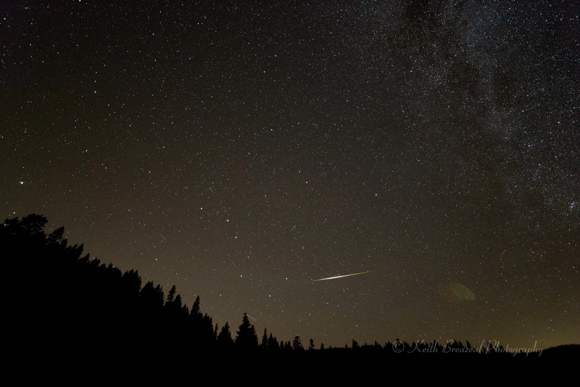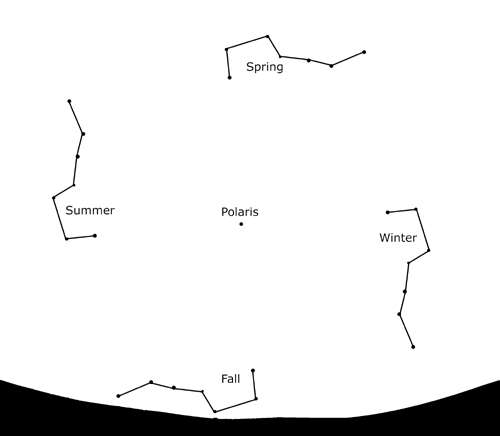![]()
Tonight’s chart shows Polaris and the Big and Little Dippers for a September evening. You can use the Big Dipper to find Polaris, which is also known as the North Star. Notice that a line from the two outermost stars in the bowl of the Big Dipper points to Polaris. And notice that Polaris marks the tip of the handle of the Little Dipper.
The northern sky is a large clock, with Polaris at its center. The hour hand is a line drawn through Dubhe and Merak, the two pointer stars of the Big Dipper. Because the stars make a full circle in 23 hours 56 minutes instead of exactly 24 hours, this star clock is not exactly the same as the one on the wall, but with a little practice you can learn to read it well.
The Big and Little Dippers: All you need to know
EarthSky astronomy kits are perfect for beginners. Order today from the EarthSky store

View larger. | Keith Breazeal’s photo of a meteor streaking past the Big Dipper during the 2015 Perseid meteor shower. Captured at the Bear River Dam in the California Sierra Nevada mountains. Can you find Polaris in this photo?
The Big Dipper swings full circle – 360 degrees – around Polaris in about 23 hours and 56 minutes. In 24 hours, the Big Dipper actually swings more than full circle, or 361 degrees. Does that make a difference? Yes! It means that – if you look at the same time each evening – the Big Dipper will appear just a little bit lower in the northwestern evening sky.

If you’re in the northern U.S., Canada or at a similar latitude, the Big Dipper is circumpolar for you – always above the horizon. Image via burro.astr.cwru.edu
A month from now at mid-evening, the Big Dipper will be noticeably lower in the northwest. It’ll actually beneath the horizon as seen from the southern latitudes in the United States – although it’s circumpolar, or always above the northern horizon, as seen from the northern U.S., Canada and similarly northern latitudes.
The constant motion from night to night of these stars circling Polaris is a bit like a bear circling its prey, looking for a way to attack. Several ancient cultures from the Greeks and Romans to the Micmac Indians likened these stars to a bear.
In Greek mythology, the Big Dipper asterism represents the hindquarters and tail of the constellation Ursa Major, the Great Bear. The Micmacs saw the three stars of the Big Dipper handle as hunters chasing the bear.
Watch the Big and Little Dippers circle around Polaris tonight! To locate Polaris, the North Star, just draw a line between the two outer stars in the bowl of the Big Dipper.
Enjoying EarthSky so far? Sign up for our free daily newsletter today!
Source:
https://earthsky.org/tonight/use-big-dipper-to-find-polaris-the-north-star